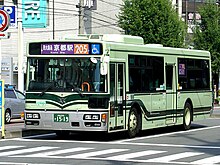|
Transport in KeihanshinTransport in the Keihanshin metropolitan region is much like that of Tokyo: it includes public and private rail and highway networks; airports for international, domestic, and general aviation; buses; motorcycle delivery services, walking, bicycling, and commercial shipping. The nexus is in the central part of Osaka, though Kobe and Kyoto are major centers in their own right. Every part of Keihanshin has rail or road transport services. Sea and air transport is available from a limited number of ports for the general public. Public transport within Keihanshin is dominated by an extensive public system, beginning with an urban rail network second only to that of Greater Tokyo, consisting of over seventy railway lines of surface trains and subways run by numerous operators; buses, monorails, and trams support the primary rail network. Over 13 million people use the public transit system daily as their primary means of travel.[1] Like Tokyo, walking and bicycling are much more common than in many cities around the globe. Trips by bicycle (including joint trips with railway) in Osaka is at 33.9% with railway trips alone having the highest share at 36.4%, the combined railway share (rail alone, rail and bus, rail and bicycle) is at 45.7%. Walking alone has a modal share of 8.5%. Private automobiles and motorcycles play a secondary role in urban transport with private automobiles only having a 9.9% modal share in Osaka.[2] AirportsPrimary Osaka Airport (Itami Airport) served 16 million domestic passengers in 2019, and Kansai International Airport served 29 million international and domestic passengers. Kobe Airport is the region's newest airport, and has mostly domestic services, with a few international charter flights, serving 3 million passengers. SecondaryYao Airport serves the area's general aviation needs. Still further across Osaka Bay into Shikoku lies Tokushima Airport, also capable of handling large planes, and a possible alternative airport for the region (for evacuation, disaster relief, emergency landings, cargo, overload etc.). There are also a number of JASDF military facilities. RailThe rail network in Keihanshin is very dense, with the average number of daily passengers topping 13 million. Railway usage and density is similar to that of Greater Tokyo, despite the smaller population base of Keihanshin. As in Tokyo, few free maps exist of the entire network; instead, most show only the stations of a particular company, and whole network maps (see, for example, this map of Keihanshin's rail network) often are confusing simply because they are so large. In addition to above-ground and below-ground rail lines, the Sanyō and Tōkaidō Shinkansen serve as the backbone of intercity rail transport. HistoryJapan's first streetcar opened in 1895 in Kyoto.[3] List of operating passenger rail linesList of cable car/funicular lines
List of incomplete/abandoned lines
Rail RidershipFollowing table lists annual ridership in millions of passengers a year, average daily in parentheses.
Note above table does not yet include figures for Kobe Municipal Subway, Kitakyu, Kobe New Transit, Kobe Rapid, Noseden, or Shintetsu. Buses There are numerous private and public bus companies with hundreds of routes throughout the region. Most bus routes complement existing rail service to form an effective intermodal transit network. TaxisTaxis also serve a similar role to buses, supplementing the rail system, especially after midnight when most rail lines cease to operate. Persons moving around the city on business often chose taxis for convenience, as do people setting out in small groups. Roads National, prefectural, and local roads crisscross the region. Local and regional highways
Expressways
Maritime transport Passenger ferriesOsaka's international ferry connections are far greater than Tokyo's, mostly due to geography. There are international ferries that leave Osaka for Shanghai, Korea, and until recently Taiwan. Osaka's domestic ferry services include regular service to ports such as Shimonoseki, Kagoshima, and Okinawa. ShippingShipping plays a crucial role for moving freight in and out of the Keihanshin area. Although in the 1970s the port of Kobe was the busiest in the world by containers handled, it no longer ranks among the top twenty worldwide. Kansai area is home to 5 existing LNG terminals.
Other modes
Greater Osaka is little different from the rest of Japan in the other modes of transport. The first automated bicycle system in the region was installed at the North Exit of Nishinomiya Station (Hanshin) in 2010, capable of handling 414 bicycles.[6] See also
References
External links
|


